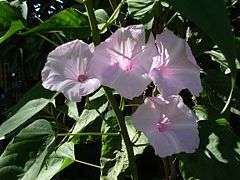Ipomoea carnea
| Ipomoea carnea | |
|---|---|
 | |
| Scientific classification | |
| Kingdom: | Plantae |
| (unranked): | Angiosperms |
| (unranked): | Eudicots |
| (unranked): | Asterids |
| Order: | Solanales |
| Family: | Convolvulaceae |
| Genus: | Ipomoea |
| Species: | I. carnea |
| Binomial name | |
| Ipomoea carnea Jace. | |
| Synonyms | |
|
Ipomoea fistulosa Mart. ex Choisy | |
Ipomoea carnea, the pink morning glory, is a species of morning glory. This flowering plant has heart-shaped leaves that are a rich green and 6–9 inches (15–23 cm) long. It can be easily grown from seeds which are toxic and it can be hazardous to cattle; the toxicity is related to the swainsonine produced by endophytes [1] and to bioaccumulation of selenium species in leaves but mostly in seeds[2]
The stem of I. carnea can be used for making paper.[3] The plant is also of medicinal value.[3] It contains a component identical to marsilin, a sedative and anticonvulsant.[3] A glycosidic saponin has also been purified from I. carnea with anticarcinogenic and oxytoxic properties.[3]
Another common name is "bush morning glory", but particularly in temperate North America, that usually refers to I. leptophylla.
In Brazil, I. carnea is known as canudo-de-pita, literally "pipe-cane", as its hollow stems were used to make tubes for tobacco pipes. It thus became the namesake of Canudos, a religious community in the sertão of Bahia, over which the War of Canudos was fought 1893–1897.
- Leaves of Ipomoea carnea plant
- Flowers of Ipomea
References
![]() Media related to Ipomoea carnea at Wikimedia Commons
Media related to Ipomoea carnea at Wikimedia Commons
- ↑ Gardner, J Agric Food Chem 64:6156 2016 PMID 27436221 doi:10.1021/acs.jafc.6b02390
- ↑ Sabogal, Ana; Dunin Borkowski (December 2007). "[Estado actual de la investigación sobre Ipomoea carnea: toxicidad en ganado caprino]". Revista de Química. Lima, Perú: Pontificia Universidad Católica del Perú (January–December 2007): 29–35. ISSN 1012-3946.
- 1 2 3 4 Chand, Navin; P. K. Rohatgi (June 20, 2005). "Impact toughness ofIpomoea carnea particulate-polyester composite". Journal of Materials Science Letters. Netherlands: Springer Netherlands. 6 (6): 695–697. ISSN 0261-8028. doi:10.1007/bf01770929.